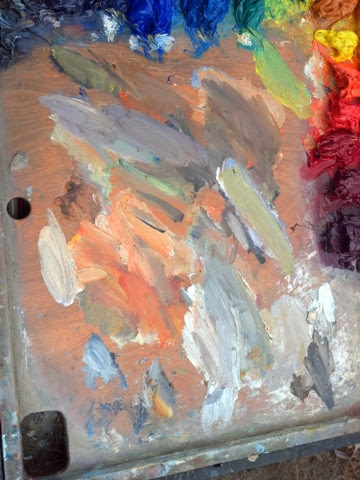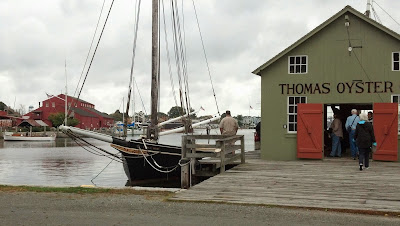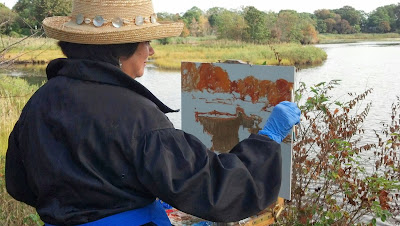Many students and fellow artists ask me for info on how I make my panels. Today was a panel making day, so I decided to post something to explain my process.
I like 359 alkyd primed linen from WindriverArts.com. Owners, Mary Rawle and her husband Chuck are the nicest people you could ever buy linen from. Sometimes I use some oil primed Italian linen from the Italian art store. It really depends on what becomes available when I need more linen. I like gator board and I buy it from a place in Connecticut called ArtGrafix.com. They are extremely prompt and their website is easy to navigate. I use the natural kraft wrap gator board. Because I am in a studio in an old mill that has a loading dock, it's easy to buy the board one or two pallets at a time. The sheets come 15 to a pallet and they are each 4 by 8 feet. Usually there are a few other artists going in on the purchase and it's a nice way to get it in quantity and then divide it up. Don't worry, they also sell different sizes, 10 to a box and you can order a box of 30 by 40 inch gator board and still have it delivered by UPS.
When I decide to make linen panels, I choose a day and I try to make all I can in a day. I use a sheet rock T square and a utility knife to cut the big sheets of gator board. I prefer to cut them to different size panels that I use on a regular basis. In this way, I am making a lot of different sizes, but I might also have some left that I can make as I need them. I cut up my linen into the sizes that I use regularly too. Generally, I add about a quarter of an inch to each side, in order to have a bit of excess that I can trim off as I make the boards. This is important, especially when I am making larger panels.
The glue I use to mount the linen to the board is a fabric adhesive. I buy it from United Manufacturers Supply Company. If you search for fabric adhesive on their website, it will come right up. I buy it in the quart size and also in half gallons. The quart size has a nice dispenser tip and therefore is useful for applying it to the gator board.
I apply the glue by squeezing it out of the bottle onto the gator board in a circular motion. You don't need tons of it, but you need enough to get the job done. Practice makes perfect. You will get a feel for it right away. The adhesive will tack up fairly quickly so once I apply it, I quickly spread it around. I just use an old bristle brush that I cut down slightly so that it is a bit stiffer for moving the adhesive. The adhesive looks somewhat like Elmer's glue but it isn't. This glue hold great, but can also be reactivated by heat which means that if it ever became necessary to remove the painting to adhere it to another panel, it can be done. It is a PH Neutral adhesive and it's completely archival.
Once I spread the adhesive around, I check that I got glue up to all the edges and then I place my linen on it and I use an old wooden ruler to press down on the panel from the middle to the edges to make sure it lays flat. I am careful not to press so hard that I squeeze all the glue out at the edges. If this happens, I am pressing too hard or have way too much glue on the panel.
Then I flip the panel over, and using my utility knife, I trim off the excess canvas. If I don't do this while the glue is wet, I will get a wavy buckle effect along the edge of the panel. It has something to do with the glue drying, causing slight shrinkage. Then I place it on a flat surface and put something on top of it to keep it flat. It doesn't have to be real heavy. I've gotten to the point that I put it under my cutting mat and place a book on top and it's ready to paint on in about 10-15 minutes.
I want to point out that I can make a 30 x 40 painting panel using this method and I can do it a heck of a lot faster than stretching a canvas. I have gone as big as 40 x 60. Making your own panels might use up some painting time, but I get satisfaction in constructing my own panels and I can make them for half of what it costs to buy them already made. In my book, every artist should concern themselves with cutting costs where possible. It's also a nice project to do with another fellow artist. One rainy spring, I made panels for 5 consecutive days with a good painting friend and by the end, we both had put together enough panels to last us for more than a year! I am providing a link here to a very simple YouTube video which shows the process.
In my next post, I will be starting a new project.
On my 30 minute drive to the studio each day, I see early morning scenes that would make great paintings, but the effects are fleeting. Then on my drive back home, the late afternoon light turns to twilight and again the effect is magical, but I see just a fleeting glimpse. It's just a moment in time. I would like to commit these to memory and paint one every day for 30 days beginning on Tuesday, March 4th. I will post these on this blog with a link to Daily Paint Works, where they will be available for purchase online for $400. Each painting will be either a 9"x12" or an 8"x10" I hope you will have a look!
I want to point out that I can make a 30 x 40 painting panel using this method and I can do it a heck of a lot faster than stretching a canvas. I have gone as big as 40 x 60. Making your own panels might use up some painting time, but I get satisfaction in constructing my own panels and I can make them for half of what it costs to buy them already made. In my book, every artist should concern themselves with cutting costs where possible. It's also a nice project to do with another fellow artist. One rainy spring, I made panels for 5 consecutive days with a good painting friend and by the end, we both had put together enough panels to last us for more than a year! I am providing a link here to a very simple YouTube video which shows the process.
In my next post, I will be starting a new project.
On my 30 minute drive to the studio each day, I see early morning scenes that would make great paintings, but the effects are fleeting. Then on my drive back home, the late afternoon light turns to twilight and again the effect is magical, but I see just a fleeting glimpse. It's just a moment in time. I would like to commit these to memory and paint one every day for 30 days beginning on Tuesday, March 4th. I will post these on this blog with a link to Daily Paint Works, where they will be available for purchase online for $400. Each painting will be either a 9"x12" or an 8"x10" I hope you will have a look!

















